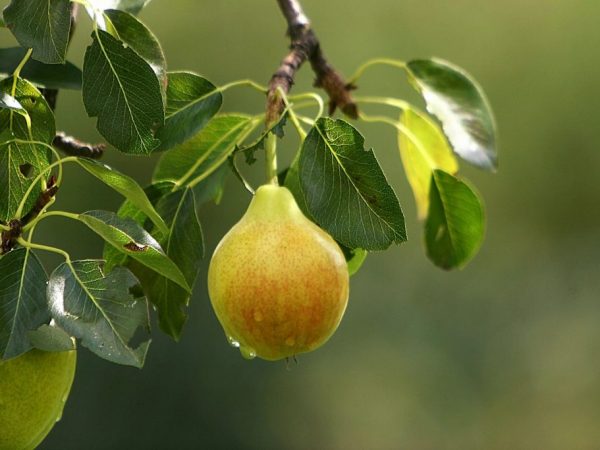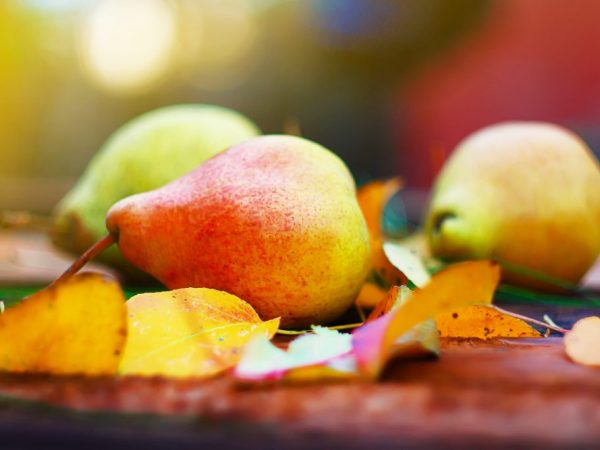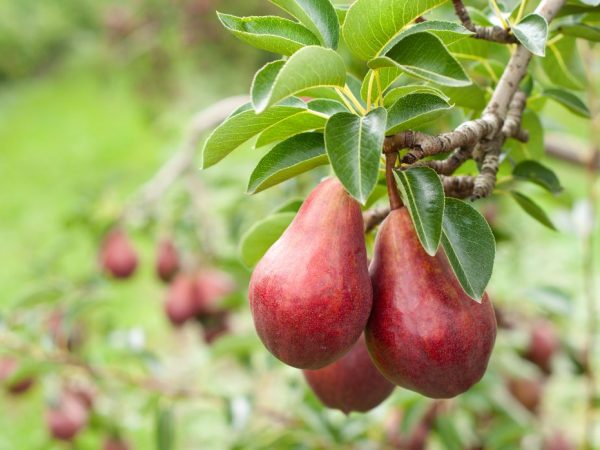Description of late varieties of pears
The pear belongs to the thermophilic trees, therefore, species of early and medium ripeness were grown for a long time. After a while, the selection specialists were able to breed late varieties of pears that are not afraid of frost.

Description of late varieties of pears
Characteristic
Late pear ripens by late September or early October.
The harvest time ranges from 8 to 12 days. If you do not collect them on time, then they crumble. After storage, they can be stored from one to eight months, subject to the correct temperature regime.
The best varieties of late pears
Veles
A variety called Veles ripens in September. Begins to bear fruit after 5 years. Fruits reach 200 g. Their peel is green-yellow, and inside them is light flesh. You can harvest up to 100 kg from one young tree. You can store them until the end of December, keeping the temperature no higher than 2 ° C. It is better to pick them slightly unripe. This will increase the shelf life. With a large number of ovaries, it is worth thinning. This procedure will help to increase the weight of each ovary by at least 10%.
Advantages of the variety:
- stable fruit picking;
- frost resistant;
- is immune to most diseases;
- very sweet fruits.
Moscow
Fruits of the Moskovskaya variety ripen by the beginning of September. The first collection is done 6 years after planting the seedlings. One fruit weighs about 150 g. Its skin is green with yellow streaks. A very juicy and sweet fruit. Their yield is average. Young trees have a spreading crown, while older trees have a wide pyramidal shape.
Advantages of the variety:
- good harvest;
- tolerates cold well;
- bears fruit every year.
Kuban
The Kubanskaya variety bears fruit in the fourth year after planting. It can produce up to 100 kg. harvest. Fruit formation begins by the end of September, but the fruit is allowed to mature after harvest. The pear weighs up to 150 g. The fruits are green, and the inside is sweet white flesh. The harvested crop can last until the end of December. Fruits do not tolerate frost well.

Large and sweet pears
Advantages of the variety:
- quickly forms an ovary;
- not afraid of most diseases;
- frost-resistant;
- the crop can be harvested every year.
Yakovleva
The Yakovlev variety is classified as winter. It is considered early-growing because it yields a harvest after 5 years. It is harvested unripe at the end of September. One fruit can reach 220 gr. The skin color is green, and the flesh is light inside. The taste is sweet with a slight sourness. Stored under temperature conditions until early March. This species is susceptible to scab infection and does not like freezing.
Advantages of the variety:
- gives a large harvest;
- stored for a long time.
Leninakan
According to the description, the late Leninakan pear ripens in September. It produces its first crop after 5 years. From it alone, you can collect about 150 kg. They are quite large. On average, there are from 350 to 600 g. Color - green. Creamy pulp inside.After collection, it changes color to yellow. You can keep this look from 2 to 4 months.
The tree and fruits can be affected by various fungal infections, so preventive irrigation is necessary. Also, the variety does not like frequent watering.
Advantages of the variety:
- fruit size;
- big harvest;
- delicious fruits;
- tolerates severe frosts.
Growing pears
Choosing a landing site

The right place guarantees a good result
A properly selected area for planting pears is an important criterion for obtaining a large harvest. It is preferable to plant trees on a wide-wavy relief with gentle slopes. Late pear varieties grow well on the southern, southwestern and southeastern slopes.
In addition, the power of the humus horizon must be observed. It should be 20 cm or more, as well as from a pH value of 5 to 6.5.
Preparing the soil for planting
The preparation can be carried out both for home gardens and for industrial gardens. In the first case, it is produced:
- advance preparation of pits;
- irrigation and filling with mineral fertilizers.
In the second, it is customary to carry out:
- enrichment of the ground cover with organic and mineral fertilizers;
- deep plowing of the earth with a tractor.
Landing in the soil
The optimal time for planting is autumn. Planting can be carried out before the soil freezes. To accelerate the growth of planting material, watering is performed. It is approximately 15-25 liters per seedling. To determine if the landing was successful, you need to wait 10 to 15 days.
When planting, observe the scheme describing the planting of seedlings. On average, depending on whether they are late-ripening or late-summer varieties, they are planted at a distance of 3 or 4 m from each other.
Tree care
- high-quality insulation of the roots;
- wrapping with foil, straw or paper;
- sowing green manure;
- additionally fertilizing the soil.
How to fertilize correctly
During the first three or four years after planting, they are irrigated with nitrogen fertilizers, on average about 35-65 kg / ha. If the root system freezes, then fertilize with a 0.5% urea solution. To obtain a high-quality harvest and reduce the quality of the fruit, after its transportation, a four-time application of micronutrient fertilizer is carried out, for example, Ecolist.
Watering pears
Often, various sprayers are used for irrigation. You can also irrigate making a groove 15 cm wide around the seedling. It is carried out a couple of times in the spring and several times in the summer, while the looseness of the soil is controlled.
Diseases and pests of late pears
In the garden, there may be fungi that provoke the development of late pear diseases. Timely processing from them will save the fruits and increase their number next year.
Diseases that often affect planting:
- scab;
- fruit rot;
- sooty fungus.
Among the pests are:
- leaf gall midge;
- copperhead;
- moth.
For protection, use special means, loosening the earth, collecting spoiled crops.
Conclusion
Although there are difficulties with planting, most gardeners choose autumn and winter late varieties for harvesting. After all, the harvested crop is stored for a long time, and therefore pleases with fresh fruits, prepared compotes and jam.


